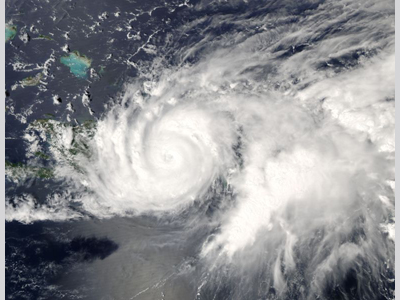The deadliest hurricane of the record-breaking 2004 Atlantic hurricane season began as a tropical wave off the coast of Africa on September 7, 2004. No significant development occurred as it crossed the Atlantic Ocean until 13 September when it became a tropical depression near Guadeloupe. The next day, as the system moved over the Leeward Islands, it became Tropical Storm Jeanne. For five days, the storm moved in a north-northwest direction at a slow pace of about 8-18 km/h (5-11 mph). It crawled over the Virgin Islands and crossed Puerto Rico on 15 September. After moving off the island and over water, it developed into a hurricane. On 16 September, the weak Category 1 hurricane made landfall on the Dominican Republic with winds of 129 km/h (80 mph). The hilly terrain of Hispaniola caused Hurricane Jeanne to lose strength and downgrade to a tropical depression. Again over water, but in a weakened state, the storm’s center dissipated. However, a new center formed just to the northeast of its previous location. The system was able to reform into a tropical storm and proceeded to move slowly northward over the southeastern Bahamas.
The tropical storm then began to make a loop over the Atlantic Ocean, about 805 kilometers (500 miles) east of the northwestern Bahamas. While doing so, the tropical storm re-strengthened into a hurricane on 20 September. By the time the loop in the hurricane’s track was complete on 23 September, Jeanne was a Category 2 hurricane with 158 km/h (98 mph) winds. A westward track then ensued and the hurricane continued to strengthen. Passing over the Bahaman islands of Great Abaco and Grand Bahama on 25 September, Hurricane Jeanne reached Category 3 intensity on the Saffir-Simpson Hurricane Wind Scale, making it the 5th major hurricane of the 2004 season. Early the next day, Hurricane Jeanne made landfall on Hutchinson Island, Florida – just 3.2 kilometers (2 miles) from where Hurricane Frances had made landfall three weeks earlier – with winds estimated to be 193 km/h (120 mph) and a top storm surge of around 1.2-1.5 meters (4-5 feet). Hurricane Jeanne weakened significantly as it moved across central Florida. It became a tropical storm 56 kilometers (35 miles) north of Tampa at 6:00 pm on 26 September and a tropical depression 24 hours later over central Georgia. Dumping heavy rain, the system moved over the Carolinas, Virginia and the Delmarva Peninsula before becoming extratropical on 29 September and moving off the Mid-Atlantic coast. The most severe impact from Hurricane Jeanne was the immense rainfall it produced. The Caribbean islands saw extreme amounts of precipitation and the consequences were deadly. At Vieques, Puerto Rico, 610 mm (24 in) of rain fell. Historic flooding occurred throughout the island causing $169.5 million (2004 USD) in damage but only claiming 8 lives. In Haiti, 330 mm (13 in) fell over the northern mountains producing catastrophic mudslides. Over 3,000 people died as a result, with almost 2,900 of them perishing in the coastal city of Gonaïves. Over two dozen people were killed in the neighboring Dominican Republic after rainfall led to flooding there as well. It is difficult to isolate the damage from Hurricane Jeanne in Florida, as much destruction was already present in this part of the state after the passage of Hurricanes Charley and Frances just weeks prior. Rainfall accumulations totaled 231 mm (9.1 in) in Palm Beach, and only 137 mm (5.4 in) were reported in Orlando. Millions were left without electricity, some for the third time in a month. As the hurricane made its way northeastward through the United States, heavy rainfall caused large amounts of flooding in conjunction with the rainfall of other recent hurricanes. Newark, DE reported 180 mm (7.1 in) of rain, and the ensuing flood trapped 41 people on a bus, requiring rescue. A strong F2 tornado touched down in northern New Castle County, DE causing $1 million (2004 USD) in damage along its 8-km (5 mi) track. In Maryland, Jeanne produced up to 100 mm (4 in) of rain, and resulting floods closed a total of 50 roads. Flash flooding occurred in the Philadelphia area as up to 152 mm (6 in) of rain fell. Similar scenarios played out in Maryland and Delaware. It was determined that, although damage amounts were less than that of those previous two hurricanes, Hurricane Jeanne caused $6.9 billion (2004 USD) in U.S. damage, placing it among the 15 costliest in that nation’s history. Fast Facts:
Sources:
Cobb, Hugh D. and Miles B. Lawrence. “Tropical Cyclone Report: Hurricane Jeanne 13 – 28 September 2004.” National Hurricane Center. 2005. Web. Franklin, James L. et al. “Annual Summary: Atlantic Hurricane Season of 2004.” Monthly Weather Review 134 (2006). Pp. 1015-1019. Web. “Hurricane Jeanne.” Wikipedia. 2009. Web. “Deadliest Atlantic Hurricanes.” Wunderground. 2010. Web. “Florida Keys.” Wikipedia. 2010. Web. Emanuel, Kerry A. Divine Wind. Oxford: Oxford University Press, 2005. Pp. 260. Sallenger, A.H., Stockdon, H.F., Fauver, L., Hansen, M., Thompson, D., Wright, C.W., and Lillcrop, J. 2006. Hurricanes 2004: An Overview of Their Characteristics and Coastal Change. Estuaries and Coasts. 29 (6A): 880–888. |


